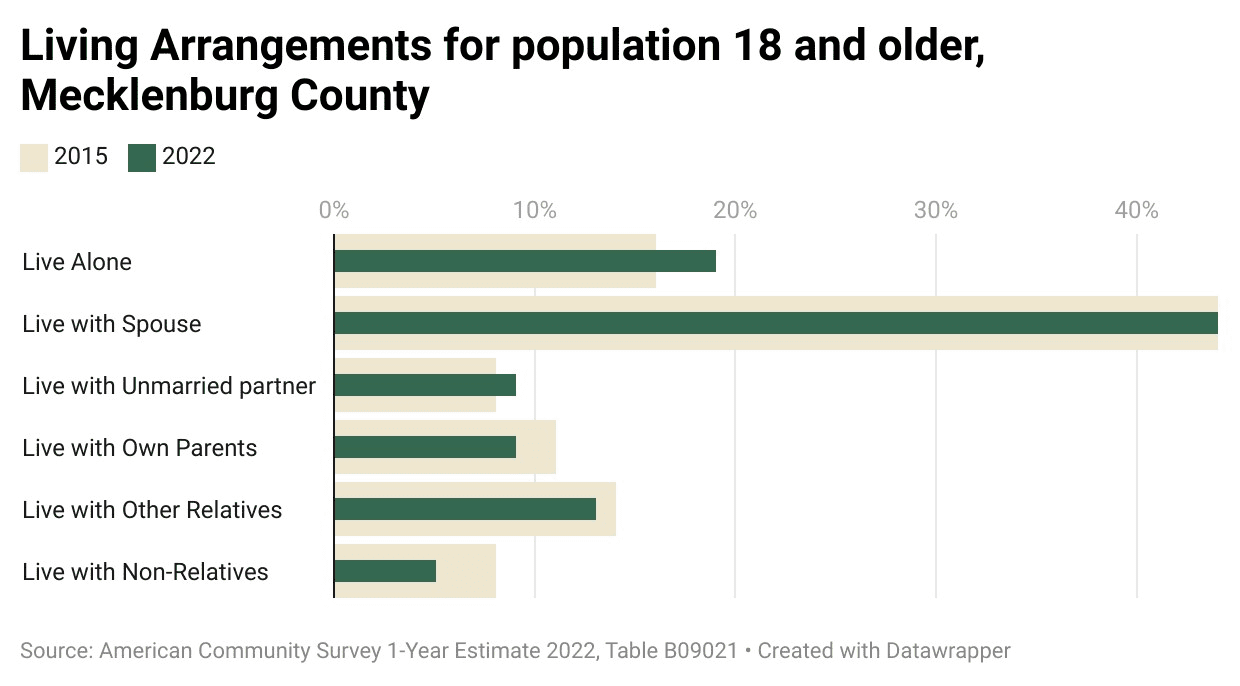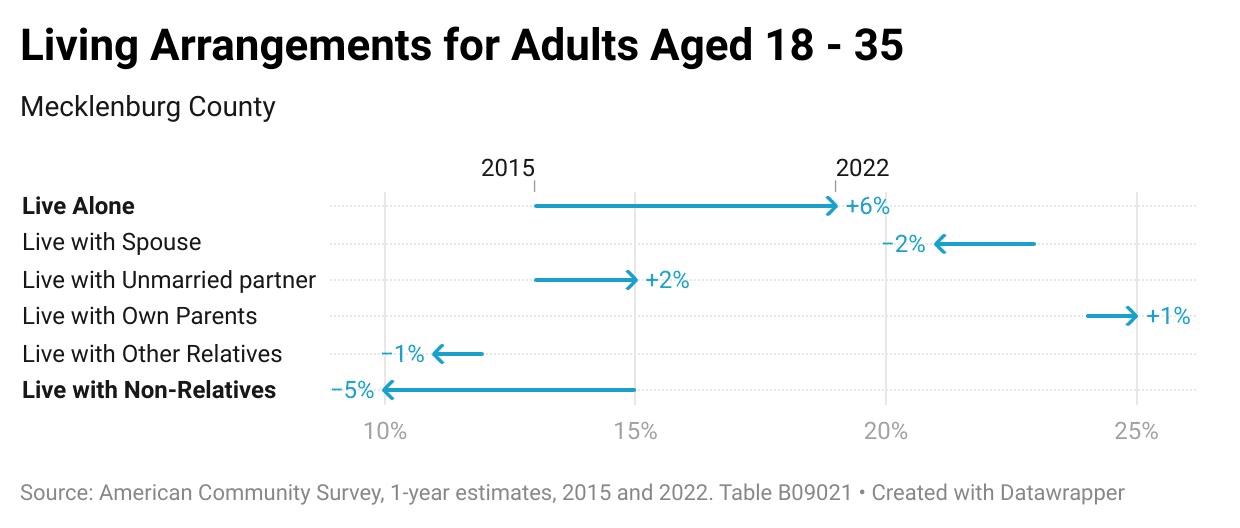More Millennials in Charlotte are choosing to live alone

Despite higher housing costs, more adults in Mecklenburg County are living on their own.
Over the past eight years, Mecklenburg County has seen a decrease in the number of adults living with non-relatives (presumably roommates), and an increase of adults living alone, or with their own children. Fewer adults are doubling-up.
In 2022, about one in five adults lived on their own. This is a slight increase from 2015, when 16% of adults lived on their own. Yet, even a slight change, combined with population growth, represents an increase of about 40,000 households countywide.
Household size and formation have tremendous implications for housing demand – more, and smaller, households require more housing units. The age and lifestyle of householders also factor into which types of housing get built where. Here, we can see exactly who is living in the thousands of apartments built in Charlotte over the last few years.

Okay, but why?
Living arrangements often change as people age, both in response to changes in housing affordability and in lifestyle. The prevailing narrative is that most people living alone are older adults – widows or empty nesters. Yet, in Mecklenburg County, the move toward single-adult households is driven by adults aged 18-34.

In both 2015 and 2022, the young adult category (ages 18-35) largely captures the millennial demographic, those born between 1980 and1997. The change in living arrangements here might simply reflect the aging and changing preferences of this population. In 2015, most millennials were in their 20s while, by 2022, the majority were in their 30s. While the proportion of partnered (married or unmarried) households remained about the same, there was a six percent increase in the percentage of young adults living alone, offset by a 5% decrease in young adults living with roommates.
It appears that high housing costs have not deterred younger adults from living alone. However, the percentage of renter households who are cost-burdened, that is spending more than 30% of their income on rent, increased from 47% in 2015 to 51% in 2022.
With all of this, you might be curious to know which demographics are living with others? Here’s what we know:
Among adults aged 35-64, more people are living with a spouse
The living arrangements of adults aged 35-64 have remained relatively constant for this group over the past eight years. The main difference was an increase in the percentage of people living with a spouse, which moved from 54% to 58%.
Among older adults, arrangements have remained about the same.
For adults 65 and older, the distribution of living arrangements have also remained about the same, with about 27% living alone. However, this was the fastest growing adult population segment in Mecklenburg County, increasing by 31% in the past eight years, compared to 14% for younger adults. There were about 36,000 older adults living alone in 2022.
More demand, less disposable income
Single-adult households might have different needs than families. For example, they might want smaller units with better access to community services and amenities. Many older adults living alone might be looking to downsize, but can’t because of costs. And while higher vacancy rates and moderating rents indicate that the Charlotte market is responding to the demand for smaller rental units, ownership opportunities are, by default, geared toward two-income households.
Indeed, living alone, or even just with a spouse and children is somewhat of a luxury. According to a 2015 survey by the Federal Reserve Bank, low-income respondents were twice as likely as middle and high-income respondents to live with someone outside of their immediate family. While the implications for quality of life are numerous, it is a very effective cost-saving measure.
Those living alone must devote a higher portion of their income to living expenses. A person renting a one-bedroom apartment on their own, spends about $7,000 more a year on rent than someone who is partnered up.
It seems however, that more young adults in Charlotte, for better or worse, are choosing to pay up.
One caveat…
It must be noted that this data-set might not entirely capture adults who are living with others temporarily, or in breach of a renter tenancy agreement. Staying with friends or family is one way those facing housing insecurity find shelter, even if it is just for a night or two. Individuals and families facing housing insecurity might also live in overcrowded conditions, or in violation of their lease agreements. The American Community Survey is reliant on survey responses from households in order to collect data and, in these conditions, respondents might not consider everyone living under their roof their “household” for reporting purposes.